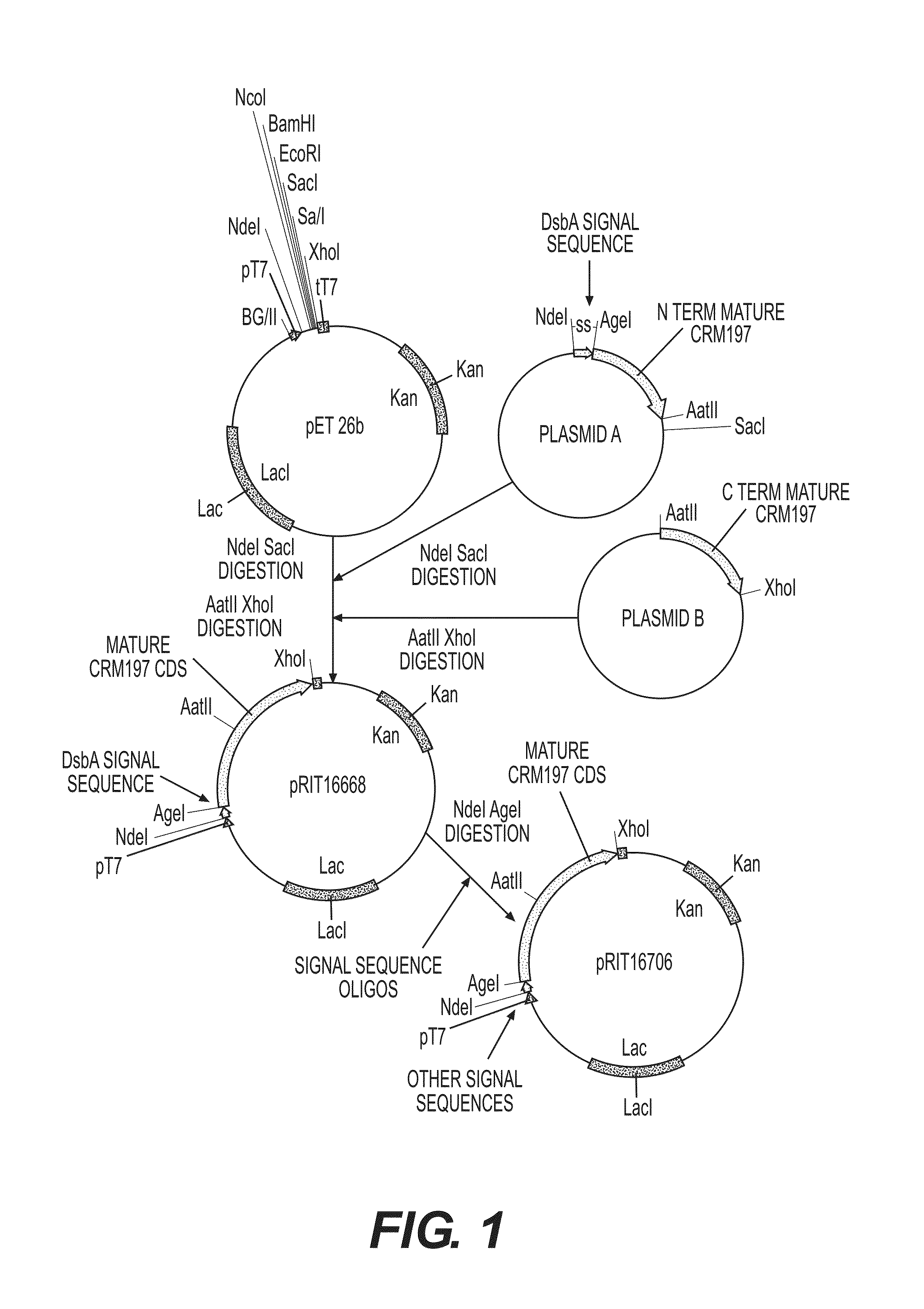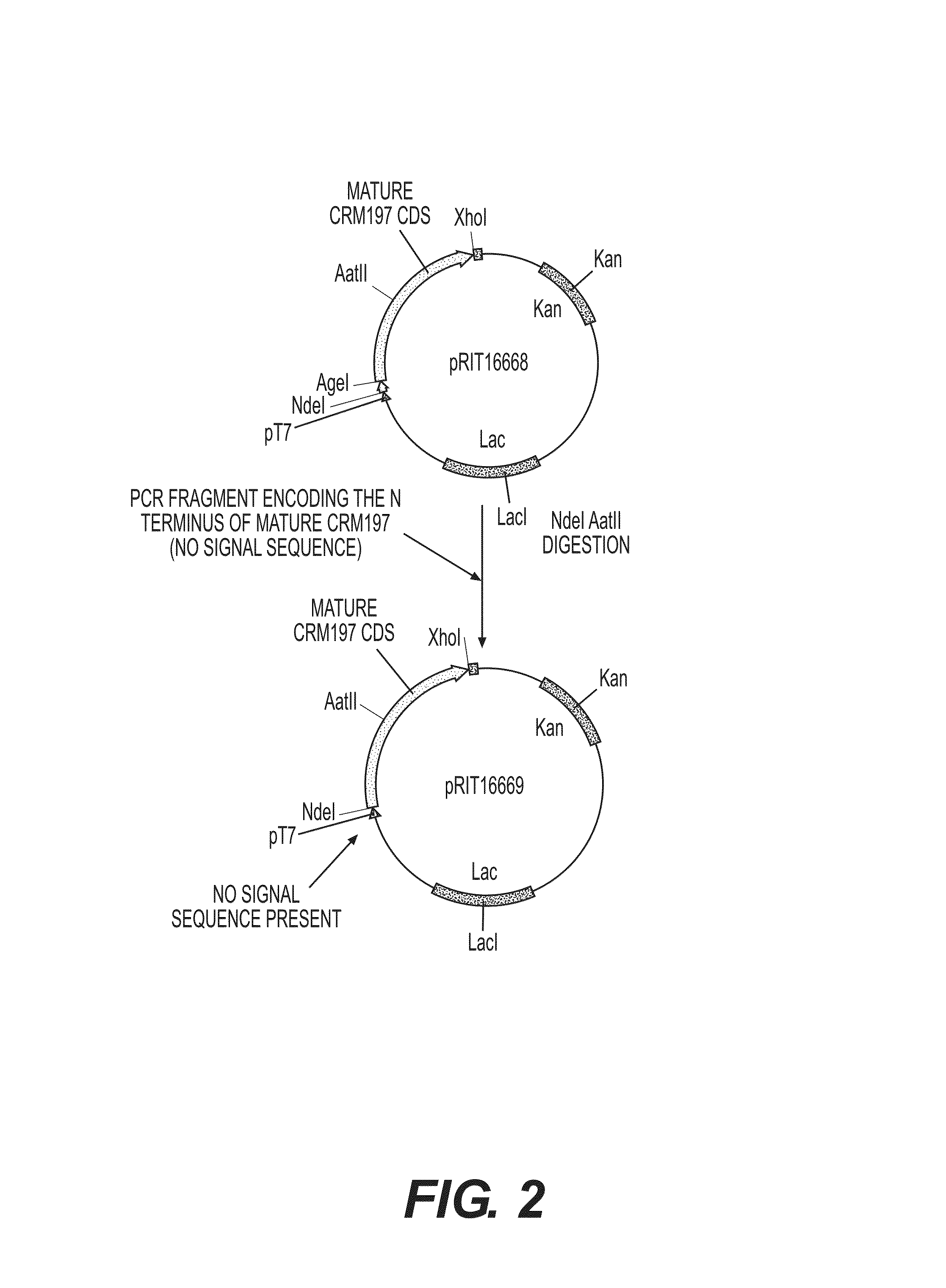Expression system
a technology of bacterial toxins and expression systems, applied in the direction of transferases, antibacterial agents, peptide sources, etc., can solve the problems of affecting the production of diphtheria toxins such as crm197 for use in vaccines, and involving certain difficulties
- Summary
- Abstract
- Description
- Claims
- Application Information
AI Technical Summary
Benefits of technology
Problems solved by technology
Method used
Image
Examples
example 1
Design of CRM197-Signal Sequence Constructs
[0200]Plasmids containing a sequence encoding an N-terminal signal sequence fused to the CRM197 toxoid were created using standard molecular biology techniques. Thirteen different signal sequences were used (table 2); these were selected from the GenEMBL database.
[0201]
TABLE 2SignalSEQ ID NOSEQ ID NOsequencenucleotideAmino acidOriginPhtE12S.pneumoniaeSipA34Group B StrepOmpA56E.coliNspA78N.meningitidisTorT910E.coliSfmC1112E.coliFocC1314E.coliCcmh1516E.coliYra11718E.coliToIB1920E.coliNikA2122E.coliFigl2324E.coliDsbA2526E.coli
[0202]The first construct was created from three plasmids (see FIG. 1). Plasmid A, created by Geneart, contained the DsbA signal sequence (SEQ ID NO:25) 3′ to a sequence encoding an N-terminal fragment of CRM197 (amino acids 1-206 of SEQ ID NO 32). This plasmid was cloned into the pET26b backbone plasmid (Novagen) by digestion of both plasmids using NdeI and SacI restrictions enzymes followed by ligation. Plasmid B, creat...
example 2
Design of a CRM197 Construct for Cytoplasmic Expression (Lacking the Periplasmic Signal Sequence)
[0206]In this experiment, a plasmid similar to those created in Example 1 but lacking the periplasmic signal sequence was created. This design process is summarised in FIG. 2. Firstly the CRM197 sequence (SEQ ID NO:31) was amplified by standard PCR techniques using two primers which were named MDSCRM1 (SEQ ID NO:27) and MDSCRM2 (SEQ ID NO:28) and pRIT16668 as the template (the temperature cycles used were (94° C. 2′-55° C. 2′-72° C. 2′30) X 25-72° C. 10′-end 4° C.).
[0207]This fragment was inserted into plasmid pRIT16668 in place of the CRM197 signal sequence insert. This was achieved using standard molecular biology techniques through digestion of the PCR product and pRIT16668 with the restriction enzymes NdeI and XhoI. The resulting plasmid contains the mature CRM197 sequence (SEQ ID NO:31) but contains no signal sequence and was named pRIT16669.
[0208]The resulting plasmids were transfo...
example 3
Design of an Optimal Signal Sequence-CRM197 Construct
[0209]The signal sequence FIgI was selected for use to create an improved construct. The cloning process followed is summarized in FIG. 3.
[0210]A region of DNA containing the FIgI signal sequence fused to the N-terminal part of the CRM197 sequence was amplified using standard PCR techniques. Two primers were used, primers named FIgI c-CRMopt3e (SEQ ID NO:29) and MDSCRM906NC (SEQ ID NO: 30) primer using pRIT16669 as template with cycling (94° C. 2′(94° C. 1′-60° C. 1′-72° C. 2′30)X3 (94° C. 1′-58° C. 1′-72° C. 2′30)X3 (94° C. 1′-56° C. 1′-72° C. 2′30)X3(94° C. 1′-54° C. 1′-72° C. 2′30)X20 72° C. 10′-end 4° C.).
[0211]This fragment was inserted into plasmid pRIT16669 using standard molecular biology techniques through digestion of the PCR product and plasmid pRIT16669 with the restriction enzymes NdeI and AatII. The resulting plasmid contains the complete mature N-terminus of CRM197(SEQ ID NO:31) and the FIgI signal sequence terminat...
PUM
| Property | Measurement | Unit |
|---|---|---|
| temperature | aaaaa | aaaaa |
| temperature | aaaaa | aaaaa |
| temperature | aaaaa | aaaaa |
Abstract
Description
Claims
Application Information
 Login to View More
Login to View More - R&D
- Intellectual Property
- Life Sciences
- Materials
- Tech Scout
- Unparalleled Data Quality
- Higher Quality Content
- 60% Fewer Hallucinations
Browse by: Latest US Patents, China's latest patents, Technical Efficacy Thesaurus, Application Domain, Technology Topic, Popular Technical Reports.
© 2025 PatSnap. All rights reserved.Legal|Privacy policy|Modern Slavery Act Transparency Statement|Sitemap|About US| Contact US: help@patsnap.com



